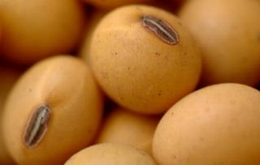 Despite a couple of factors that could be bearish to the soybean market looming on the horizon, tight supplies and continued global export demand have kept prices from dropping off a cliff.
Despite a couple of factors that could be bearish to the soybean market looming on the horizon, tight supplies and continued global export demand have kept prices from dropping off a cliff.The recent news that a new strain of avian influenza had been discovered in China -- and more importantly, the fact that it was seen transmitting between people who have no contact with potentially infected birds -- was originally seen as potentially bearish for the U.S. soybean market. It's a basic situation of supply and demand; if thousands of birds have to be culled in China, there will be fewer mouths to feed soybean meal, thereby limiting the amount of U.S. soybean purchases. Sounds good in theory, right?
"H7N9 bird flu has been in the news for several weeks now but has not really affected the grain markets," says Toay Commodity Futures Group LLC market analyst Kevin Penner. "In fact, we have seen several large new-crop soybean purchases by China in the past week."
Though the potential is there for a major swing lower in demand, right now it remains just that -- potential. If that potential is to become reality, it will take major action.
"I think we would need to see widespread pandemic-type action of this flu and news of major culling of livestock to really capture the attention of the U.S. grain markets," Penner adds.
"I hope they don't wack milions of good birds for nothing. That would not help the bean market!" says Agriculture.com Marketing Talk adviser ECIN. "But something to keep an eye out for."
The sluggish planting pace -- with a tiny fraction of this year's corn crop in the ground, well behind normal -- has some farmers weighing the potential for more soybean plantings if the corn-planting window shuts before all the intended acres can get planted. That's a typically bearish factor in a wet spring like this one, but will it reach fruition?
"There will be acres that will just not get planted. Last year was a rare year when every acre that was intended to get planted got planted. Double-crop beans are going to be a lot later, as the wheat will not come off nearly as early as last year," says Agriculture.com Marketing Talk senior contributor p-oed Farmer. "What that means is anybody's guess for sure. A lot will also depend on price . . . if the market keeps going lower, there will be less incentive to get things in late. Lots of trading to go as we move forward."
Still, the potential for more soybean acres exists, especially considering the slow planting pace of the spring wheat crop in the Dakotas and northern Corn Belt. With less than 10% of the spring wheat crop in the ground, time is running out quick, and soybeans might offer a viable alternative for those acres that can't be sown to wheat.
"By this time, you're likely to be pretty far along in your [spring wheat] plantings," says U.S. Commodities market analyst and broker Don Roose. "So, there's potential there for more soybeans."
Just don't jump to an acreage switch from either spring wheat or corn to soybeans too early, Roose adds.
"With the equipment people have now, we can go pretty fast and get quite a bit planted in a short period of time. If we get a break in the weather, we can catch up pretty quickly," he says.





